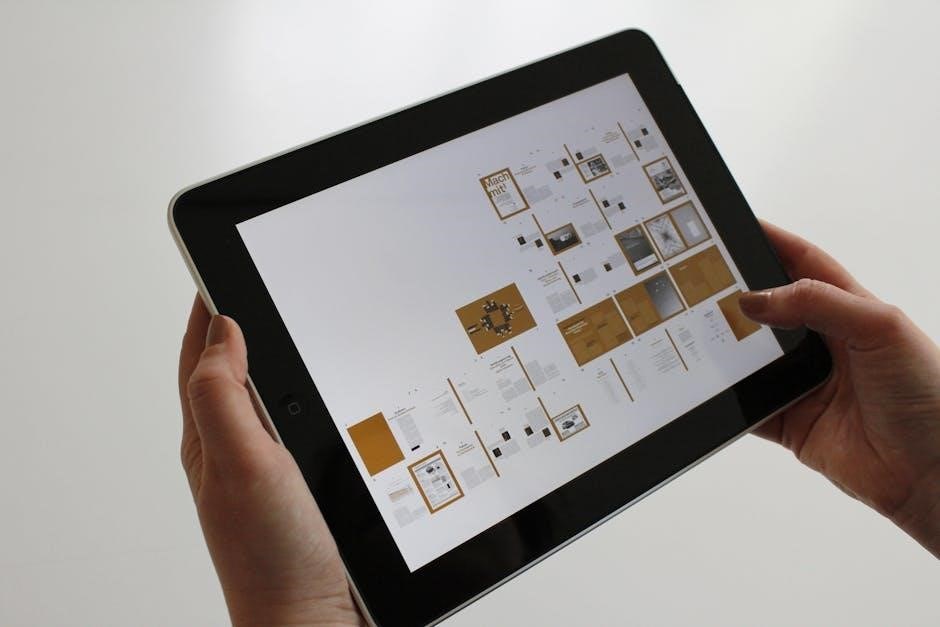The Boss ME-80 is a versatile multi-effects pedal designed for guitarists, offering COSM amp modeling, an intuitive LCD display, and user-friendly controls for effortless tone customization.
1.1 Overview of the Boss ME-80 Guitar Multiple Effects
The Boss ME-80 is a versatile multi-effects pedal designed for guitarists, offering a wide range of effects, including distortion, reverb, delay, and more. It features COSM amp modeling, providing realistic amplifier tones. The pedal includes 59 effects, allowing for up to 8 simultaneous effects, and offers 36 user presets and 36 factory presets for customization. With its clear LCD display and user-friendly interface, the ME-80 is easy to navigate. It supports both battery and DC power options, making it flexible for various setups. The comprehensive user manual ensures users can fully utilize its features, making it an essential tool for achieving high-quality guitar tones.
1.2 Importance of the User Manual
The Boss ME-80 user manual is essential for maximizing the pedal’s potential. It provides detailed instructions on navigating the control panel, understanding the LCD display, and utilizing effects effectively. The manual explains how to access and manage presets, both user and factory, ensuring seamless customization. Additionally, it covers installation, connectivity options, and maintenance tips to prolong the device’s longevity. By following the manual, users can optimize their setup, troubleshoot common issues, and explore advanced features like MIDI implementation and firmware updates. This comprehensive guide is indispensable for both beginners and experienced players, helping them unlock the ME-80’s full capabilities and enhance their musical experience.

Boss ME-80 Specifications
The Boss ME-80 features a 24-bit audio processor, offering high-quality sound. It supports both battery and DC power, ensuring flexibility. An easy-to-read LCD display enhances usability;
2.1 Key Features of the Boss ME-80
The Boss ME-80 is a multi-effects pedal offering COSM amp modeling, creating authentic tones. It includes 59 effects, with 8 simultaneous use. The LCD display is clear, aiding navigation. Battery or DC power options provide flexibility. MIDI compatibility enhances control. Preset capabilities allow 36 user and 36 factory settings. It supports BOSS Tone Studio for computer editing. The pedal is designed for both studio and live use, offering durability and portability. These features make it a versatile choice for various musical styles and professional needs.
2.2 Technical Specifications
The Boss ME-80 operates with a 24-bit bit rate, ensuring high-quality audio output. It features 59 effects, including COSM amp modeling, and supports up to 8 simultaneous effects. The pedal is digital, offering 36 user and 36 factory presets. It includes a 1/4-inch input and output, MIDI implementation for external control, and an easy-to-read LCD display. Power options include 6 AA batteries or a DC adapter. The unit weighs approximately 3.8 kg and measures 441mm x 242mm x 78mm. These specifications ensure reliability and versatility for both studio and live performance settings, making it a robust tool for professional guitarists.
2.3 Compatibility and Connectivity
The Boss ME-80 ensures seamless integration with various devices, featuring MIDI in, MIDI out/thru, and a USB port for computer connectivity. It supports Boss Tone Studio software, enabling preset management and firmware updates. The pedal is compatible with both Mac and Windows systems, making it versatile for studio and live setups. It also includes a 1/4-inch input and output for direct connection to guitars and amplifiers. Additionally, the ME-80 supports external controllers, enhancing performance flexibility. Its robust connectivity options make it a reliable choice for musicians seeking advanced tonal control and customization. This ensures the ME-80 adapts to diverse musical environments effortlessly.

Installation and Setup
The Boss ME-80 setup involves unboxing, connecting your guitar, and choosing between battery or DC power. Ensure proper installation for optimal performance and functionality.
3.1 Unboxing and Initial Setup
Unboxing the Boss ME-80 reveals a sleek, compact multi-effects pedal designed for guitarists. Inside, you’ll find the ME-80 unit, a power adapter, USB cable, and the owner’s manual. Begin by ensuring all components are included and undamaged. For initial setup, place the ME-80 on a flat surface and connect your guitar using a standard 1/4-inch cable. Power the unit using the included DC adapter or six AA batteries for portability. Turn on the pedal and familiarize yourself with the control panel, LCD display, and footswitches. Refer to the manual for detailed instructions on navigating menus and customizing settings. Proper setup ensures optimal performance and ease of use.
3.2 Connecting the ME-80 to Your Guitar
To connect your guitar to the Boss ME-80, use a standard 1/4-inch guitar cable. Plug one end into your guitar’s output jack and the other into the ME-80’s INPUT jack. Ensure the connection is secure to avoid signal loss. The ME-80 is designed to accommodate both active and passive guitars, providing clear and consistent audio. Once connected, power on the ME-80 using the DC adapter or batteries, and your guitar’s signal will be ready to process through the effects. Proper connection ensures optimal sound quality and prevents potential issues during performance or recording. Always verify the cable’s condition for reliable operation.
3.3 Power Options: Battery vs. DC Power
The Boss ME-80 offers flexible power options to suit your needs. It can be powered using six AA alkaline batteries, providing approximately 10 hours of continuous operation. For extended use, a DC power adapter is recommended, ensuring reliable performance during gigs or studio sessions. Batteries are ideal for portability, while the DC adapter is better for stationary setups. Always use high-quality batteries to maintain consistent power delivery. When using batteries, ensure they are fresh to avoid signal interruption. For prolonged use, the DC adapter is the preferred choice, offering steady power and eliminating battery replacement hassles. This dual power system ensures the ME-80 remains operational in any setting, catering to both convenience and performance demands.

Getting Started with the ME-80
Power on the ME-80, navigate the intuitive control panel, and explore its user-friendly interface. Start with manual mode for stompbox-style simplicity, then access presets as needed.
4.1 Navigating the Control Panel
The ME-80’s control panel is designed for intuitive operation, featuring knobs, buttons, and an LCD display. The LCD screen provides clear visual feedback, while the cursor buttons allow easy navigation between parameters. Each knob corresponds to specific functions like tone shaping, effects levels, and amp modeling. Use the cursor to scroll through menus and adjust settings. Dedicated buttons enable quick access to effects categories, such as overdrive, delay, and reverb. The panel’s layout ensures seamless interaction, making it easy to tweak sounds and save custom presets. This user-friendly design helps guitarists focus on their music while exploring the ME-80’s extensive capabilities.
4.2 Basic Operation and Knob Functions
Operating the ME-80 begins with selecting an effect or preset using the cursor buttons and LCD display. Each knob adjusts specific parameters, such as level, tone, or time, depending on the selected effect. The rotary encoder allows quick scrolling through menus, while the enter button confirms selections. Dedicated knobs for overdrive, delay, and reverb simplify real-time adjustments. The manual mode enables stompbox-style operation, letting you tweak effects on the fly. The ME-80’s knobs provide precise control over your sound, ensuring easy customization. This straightforward design makes it easy to dial in your desired tone without navigating complex menus, keeping your focus on playing.
4.3 Understanding the LCD Display
The ME-80’s LCD display is a central interface for navigating effects, presets, and settings. It provides clear, backlit visibility, showing effect types, parameter values, and preset names. Use the cursor buttons to scroll through options and the enter button to select. The display updates in real time, reflecting adjustments made via knobs or footswitches. In Manual Mode, it shows stompbox-style parameter adjustments, while in Preset Mode, it displays preset names and effect chains. The LCD’s intuitive design ensures easy navigation, making it simple to manage complex effects and customize sounds efficiently. This feature enhances the ME-80’s user-friendly experience, keeping you focused on your music.

Operation Modes
The ME-80 offers Manual Mode for stompbox-style control and Preset Mode for accessing and managing custom or factory presets, catering to both live and studio needs effectively.
5.1 Manual Mode: Simplified Stompbox-Style Operation
The Boss ME-80’s Manual Mode provides a straightforward, stompbox-like experience, allowing real-time control of effects without navigating through presets. This mode simplifies operation, making it ideal for live performances. Each effect can be adjusted individually using dedicated knobs, offering immediate tonal tweaks. The intuitive interface mimics traditional pedal functionality, enabling seamless transitions and adjustments during gigs. Manual Mode is perfect for musicians who prefer a hands-on approach, focusing on simplicity and ease of use. While it doesn’t store custom settings, it delivers instant access to essential effects, ensuring a dynamic and responsive playing experience.
5.2 Preset Mode: Accessing and Managing Presets
Preset Mode on the Boss ME-80 allows users to access and manage both factory and user-created presets, offering a convenient way to organize and recall custom sounds. The ME-80 features 36 user presets and 36 factory presets, providing ample storage for diverse tonal configurations. Navigating through presets is straightforward using the LCD display and control panel. Users can scroll through presets, select favorites, and even customize existing ones to suit their playing style. This mode is particularly useful for live performances, enabling quick transitions between sounds. Additionally, the ability to save and manage presets ensures that musicians can easily retrieve their preferred settings, enhancing both efficiency and creativity during practice or gigs.

Effects and Processors
The Boss ME-80 offers 59 effects, including overdrive, delay, and reverb, with up to 8 simultaneous effects. COSM amp modeling delivers realistic amp tones, enhancing versatility for guitarists.
6.1 Types of Effects Available on the ME-80
The Boss ME-80 provides a diverse range of effects, including distortion, overdrive, delay, reverb, chorus, and flanger. It also features COSM amp modeling, allowing for realistic simulations of classic amps. Additionally, the ME-80 includes modulation effects like tremolo and phaser, as well as a noise suppressor for controlling unwanted noise. With a total of 59 effects, guitarists can achieve a wide variety of tones, from clean and subtle to heavily processed and complex sounds. This versatility makes the ME-80 a powerful tool for both live performance and studio recording.
6.2 Using COSM Amp Modeling
The Boss ME-80 features COSM (Composite Object Sound Modeling) amp modeling, allowing guitarists to simulate a wide range of classic and modern amplifiers. Users can choose from various amp types, including clean, crunch, and high-gain options, each with authentic tonal characteristics. The COSM technology ensures that the nuances of each amp, such as preamp and power amp responses, are accurately captured. To use COSM, simply select the desired amp model via the control panel and adjust settings like gain, bass, mid, and treble to tailor the sound. This feature provides flexibility for achieving diverse tones, from vintage warmth to modern aggression, making it ideal for both live performance and studio recording.
6.3 Customizing Effects and Saving Settings
The Boss ME-80 allows for extensive customization of effects, enabling users to tailor their sound to suit any musical style. By navigating through the LCD display and using the control knobs, players can adjust individual effect parameters, such as delay time, reverb level, or distortion gain. Once a desired configuration is achieved, settings can be saved to one of 36 user memory locations for quick recall. This feature ensures that custom tones are preserved and easily accessible during performances or recording sessions. The ability to save and organize unique effect combinations makes the ME-80 a powerful tool for musicians seeking versatility and precision in their sound.

Memory and Presets
The Boss ME-80 offers 36 user memory slots and 36 factory presets, allowing seamless storage and recall of custom tones for enhanced creativity and efficiency.
7.1 User Memory: Creating and Managing Custom Presets
The Boss ME-80 allows users to create and manage custom presets with ease. With 36 user memory slots, you can store unique tones tailored to your playing style. Navigate to the preset menu using the control panel, then select an empty slot to save your current settings. Use the LCD display to name your preset for easy identification. The ME-80 also supports advanced editing through Boss Tone Studio software, enabling deeper customization and organization of your sounds. This feature ensures that your custom tones are always accessible, making it simple to switch between sounds during performances or practice sessions.
7.2 Factory Presets: Overview and Usage
The Boss ME-80 comes equipped with 36 factory presets, providing a diverse range of tones to suit various musical genres and playing styles. These presets are carefully crafted to showcase the unit’s capabilities, from clean tones to heavy distortions. Users can easily access these presets via the LCD display and navigation controls. The factory presets serve as a solid foundation for understanding the ME-80’s features and inspiring creativity. They are ideal for beginners looking to explore different sounds and for experienced players seeking reliable, high-quality tones. The presets can also be used as a starting point for customizing your own unique sounds, enhancing your musical expression.

Utility Functions
The Boss ME-80 includes essential utility functions like MIDI implementation, memory backup, and firmware updates, ensuring seamless operation, customization, and maintenance of your multi-effects processor.
8.1 MIDI Implementation
The Boss ME-80 supports MIDI implementation, allowing advanced control and integration with external devices. MIDI capabilities enable you to synchronize effects, control parameters, and manage presets via MIDI messages. This feature is particularly useful for live performances and studio setups, offering seamless connectivity with MIDI-compatible equipment. By utilizing MIDI, you can enhance your workflow, automate functions, and access a wider range of creative possibilities. The ME-80’s MIDI implementation ensures compatibility with modern music production environments, making it a versatile tool for both amateur and professional musicians aiming to expand their sonic capabilities efficiently.
8.2 Memory Backup and Restoration
The Boss ME-80 allows users to backup and restore their custom settings, ensuring your presets and configurations are safe. Use the Boss Tone Studio software to transfer user memories to your computer, providing a reliable backup solution. This feature is essential for protecting your unique tones and settings. Restoring memory is straightforward, either from the internal backup or via the software. The ME-80 provides 36 user memory slots and 36 factory presets, giving ample space for customization. Regular backups are recommended to prevent data loss. This functionality ensures that your musical creations remain intact, offering peace of mind for performers and producers alike.
8.3 Firmware Updates
Firmware updates for the Boss ME-80 are essential for maintaining optimal performance and accessing new features. Use the Boss Tone Studio software to check for and install the latest firmware via USB connection. Ensure the ME-80 is connected to your computer and powered on before starting the update process. Follow the on-screen instructions carefully to avoid interruptions, as this may affect the unit’s functionality. Updates often include improvements, bug fixes, and new features to enhance your musical experience. Regularly checking for updates ensures you have the latest advancements in tone and operation. This process is straightforward and recommended for all users to keep their ME-80 up-to-date.

Maintenance and Troubleshooting
Regularly clean the LCD display and verify all connections to prevent issues. Update firmware via Boss Tone Studio for optimal performance. Troubleshoot common problems like distorted audio or connectivity issues by resetting to factory settings or consulting the user manual.
9.1 Cleaning and Maintaining the ME-80
Regular cleaning and maintenance are essential to ensure the Boss ME-80 operates at its best. Use a soft, dry cloth to gently wipe the LCD display and control panel, avoiding harsh chemicals. For stubborn marks, lightly dampen the cloth with water, but ensure no moisture seeps into the device. Clean the footswitches and knobs with a dry cloth to prevent dust buildup. Avoid exposing the ME-80 to extreme temperatures or humidity. Store it in a protective case when not in use to prevent scratches and damage. Always use the provided DC adapter or batteries as specified to maintain proper power management. Regularly inspect cables and connections for wear or corrosion. By following these steps, you can extend the lifespan and performance of your ME-80.
9.2 Common Issues and Solutions
If the ME-80 fails to power on, ensure the battery compartment is clean and batteries are correctly installed or use the DC adapter. For distorted audio, check all cable connections and ensure they are secure. If the LCD display is unresponsive, restart the device or update the firmware. If effects fail to load, reset the ME-80 by holding the EXIT button while powering on. For connectivity issues with BOSS Tone Studio, ensure the USB driver is installed correctly and the device is properly connected. Regular firmware updates can resolve many operational issues, so check the BOSS website for the latest version.

Advanced Topics
Explore advanced features like BOSS Tone Studio integration, MIDI control, and firmware updates to maximize the ME-80’s potential for custom tones and seamless workflow.
10.1 Using Boss Tone Studio for ME-80
The BOSS Tone Studio software enhances the ME-80 experience, allowing users to edit and organize presets via USB connection. It simplifies workflow, enabling deep customization of tones and effects. MIDI implementation integrates seamlessly, offering advanced control and synchronization. Users can backup and restore settings, ensuring their unique sounds are preserved. The software provides a user-friendly interface to tweak parameters and arrange patches efficiently. Available for both Windows and macOS, it ensures compatibility and accessibility for all users. This powerful tool unlocks the full potential of the ME-80, making it an essential companion for serious musicians and producers seeking precise tone control and scalability.
10.2 Syncing Presets with Your Computer
Syncing presets with your computer via the BOSS Tone Studio software allows for efficient backup and management of your custom tones. Connect the ME-80 to your computer using a USB cable and launch the software. This enables easy transfer of user and factory presets, ensuring your sounds are safely stored. The software also allows you to share custom tones online, expanding your creative possibilities. Regular backups prevent data loss, and syncing ensures your presets are up-to-date across devices. This feature is essential for musicians who rely on consistent tones during performances and recordings, making it a valuable tool for maintaining and organizing your sound library.
10.3 Advanced Editing and Customization
The BOSS ME-80 offers advanced editing and customization options through its intuitive interface and the BOSS Tone Studio software. Users can dive deep into parameter adjustments, creating highly personalized tones. The LCD display provides clear visibility of settings, while the robust knob layout allows for precise control. External controllers can be assigned to specific functions, enabling real-time adjustments during performances. The user manual details these advanced features, ensuring users can unlock the ME-80’s full potential. This level of customization makes the ME-80 a powerful tool for musicians seeking unique and intricate sound designs, tailored to their artistic vision.
The Boss ME-80 is a powerful, versatile multi-effects pedal offering extensive customization and ease of use, making it an essential tool for guitarists seeking professional-grade tones and effects.
11.1 Summary of Key Features and Benefits
The Boss ME-80 offers a wide range of features, including COSM amp modeling, 59 effects, and an intuitive LCD display for easy navigation. It provides 36 user and 36 factory presets, allowing for extensive customization. The pedal supports MIDI implementation and includes utility functions like memory backup and firmware updates. With both battery and DC power options, it ensures flexibility for gigs and practice sessions. Its robust design and user-friendly interface make it a reliable choice for guitarists seeking professional-grade tones and effects. These features combined create a versatile and powerful tool for musicians of all levels.
11.2 Final Tips for Getting the Most Out of Your ME-80
To maximize your experience with the Boss ME-80, explore its preset library and customize settings to suit your playing style. Regularly update firmware to access new features and improvements. Use the LCD display to navigate effects and presets efficiently during performances. Experiment with COSM amp modeling to achieve authentic tones. Organize your presets into user memory for quick access. Utilize MIDI functionality for seamless integration with other devices. Backup your settings to avoid data loss. Finally, take advantage of the Boss Tone Studio software for advanced editing and syncing with your computer. With these tips, you can unlock the ME-80’s full potential and enhance your musical creativity.
